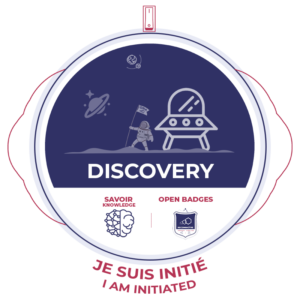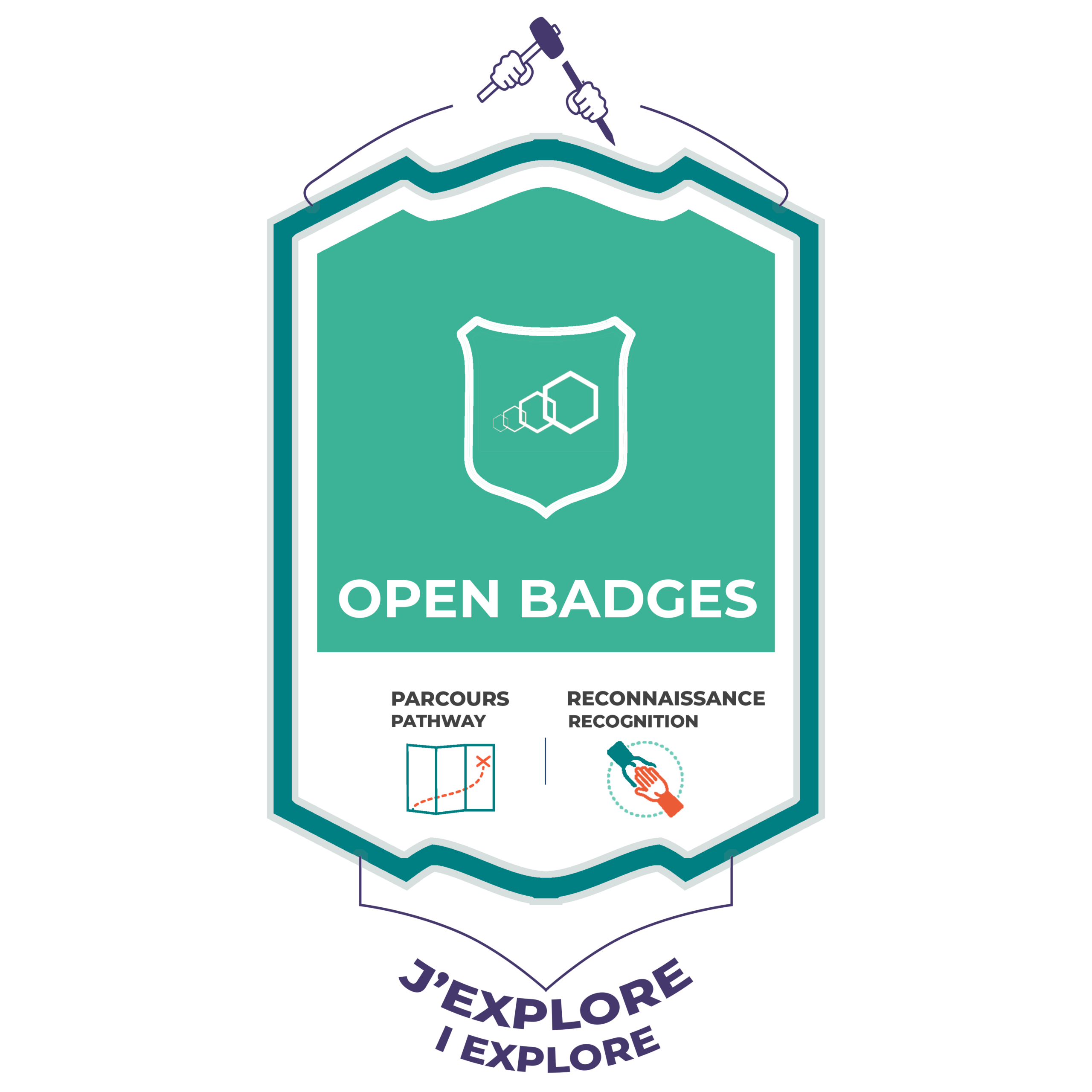Discover the
Open Badges
A bit of history

2019 ...
The Open Badges are now being used at the highest level and have integrated various measures such as the SIP (Skills Investment Plan), the FIP (Future Investment Plan) and Erasmus+ projects.
Many Open Badges initiatives have been launched in many countries, particularly in France where the community is very active and innovative. Several Open Recognition collectives have been created: Reconnaître – ORA in France (to which are added regional collectives), Open Recognition Belgium and Open Recognition Netherlands. All these collectives are members of the Open Recognition Alliance.
The little lexicon of Open Badge
- Baking a badge: This term is used when we talk about issuing a badge, when the data it contains will be “baked” into the badge like the ingredients of a cake.
- Date of issue: the day the badge was issued.
- Badge request: form from which a person can request a badge
- Ecosystem: environment around the badge (actors, beneficiaries, etc.)
- Issuance of a badge: action of issuing, allocating a badge to a beneficiary.
- Issuer: the person, organization or community that issues the badge.
- Endorse: action of validating, recognizing the value of a badge, an organization, or approving what is recognized to the recipient.
- Recipient: the person to whom the badge is issued
- ePIC: annual conference organised by the association Reconnaître around Open Recognition and Open Badges
- Open Badge: Open Digital Badge
- Open Badge Course: training course or other type of course based on Open Badges
- Passport or Backpack: digital space where you can receive, manage and share your Open Badges
- Validity period: the period for which the badge is considered valid.
- Open recognition: a concept where everyone can recognize and be recognized for their skills, know-how, etc.
What's in an Open Badge?
An Open Badge is a digital image in which information, called metadata, is stored. Since the badge is used to recognise something, the information contained in the badge will be related to what is recognised:
- Who issued the badge?
- Who is the badge recipient?
- What does it recognise and on what criteria was it issued?
- Is evidence attached to the badge?
- When was it issued?
An Open Badge for what?
A digital tool at the service of recognition
An Open Badge is used to recognize, value and make visible a skill, a know-how, a know-how to be, a commitment, a role, a contribution, a participation, an achievement, a project or simply an interest.
More importantly, what can we do with a Open Badge?
Valuing and making visible non-formal and informal experiences and learnings

The need to be recognised for one’s skills, work, life skills or achievements has always been the driving force behind a strong commitment. But, beyond responding to a need, the practice of recognition is a very powerful tool to mobilise people, to strengthen self-esteem and thus develop self-confidence and, moreover, to stimulate commitment.
Open Badges, as tools for recognition, can thus be used to value and make visible everything that is part of the human experience and that we learn throughout our lives: from the ability to solder printed circuits to the ability to resolve a conflict between employees, from the ability to change a bicycle tire to the ability to change a car engine part, from basic gardening knowledge to the ability to unite a community around an eco-citizen farm project, etc.
Opening recognition and connecting individuals, communities and organisations
Open Badges now make possible multidirectional recognition, where it is no longer only institutions or organisations that hold the monopoly on recognition, but where everyone, individuals, communities, organisations and institutions can recognise and be recognised.
By making all these recognitions visible, Open Badges promote closer ties between individuals, between individuals and communities, between communities themselves, etc.
(Part 2/3 of the code to obtain the “Curiosity” badge: vxp2)
Who can issue badges?
If one is led to think, at first glance, that only organisations or institutions (the formal world, so to speak) are able to create and issue Open Badges, in reality this is not the case. Anyone can create and issue badges, because anyone can recognise and has the right to be recognised!
One can, therefore, imagine the creation of badges in different contexts:
The récipient creates his or her own badge: the recipient considers that he or she possesses a certain skill, knowledge or other and will build his or her badge by filling in all the necessary information (including proof).
The organisation creats the badge: the creation and issuance of badges can arise from a desire to enhance the experiences of users, members and staff, and more specifically what results in terms of skills and knowledge.
The badge is co-created: This can take place in the context of collaboration between different actors, for example, an organisation and a learner, a community of practice, a territorial collective, a network of associations, etc.
What is the value of a badge?
“If anyone can issue a badge, then what’s the value of the badge?” A question that may seem legitimate, but which in reality places the reflection in a way of thinking where the value of a badge would come from the sole notoriety of the organisation or institution that issues it. But we must try to think differently, because Open Badges are much more than that!
Don’t think badge, think badge ecosystem!
An isolated badge is of little interest in itself. Its real value lies in the fact that it has meaning in a given environment, a network, a community of practice. It therefore has value in context!
When it is taken out of this context, i.e. out of the environment in which it had “native recognition”, its value can be questioned. To remedy this, various possibilities are available to the recipient of the badge or to the organizations or communities that issue them:
- Feeding the badge through new experiences;
- obtaining endorsements.
Feeding its badge with new evidence
As it is technically possible (see the Technical Specifications section of the Open Badge standard), it is interesting to associate evidence or traces to the badge, which can attest or reinforce what it recognises. These can be of any kind, as long as they make sense and can be digitally linked to the badge.
If these proofs can be “baked” into the badge when it is issued to the beneficiary, the Open Badge Passport community platform allows to feed the badge after it has been issued (see Tutorials), i.e. to add additional and subsequent proofs.
Endorsement: a way to increase the value of a badge
To fully understand how endorsement can enhance the value of a badge, one must first understand the meaning of the term. To endorse is to approve, to validate.
Thus, by endorsing a badge, I approve what it recognises. By endorsing an organisation or a community, I recognise its value. Finally, by endorsing a badge, I approve, I confirm what the badge recognises. The more numerous and “quality” they are, the more value the badge will have. Find out more about endorsement
Open Badges within the company?
The implementation of a recognition system based on Open Badges – within a company, a network of companies or even a group of employers – can bring undeniable added value to all the players in this system.
For the company, the Open Badges could thus make it possible:
- to get to know its employees better, by identifying their know-how, skills and competencies, and their areas of interest;
- to map these elements in order to make visible the strengths and weaknesses of the company, to highlight the needs in skills or training;
- to maintain the employability of employees in their functions;
- to enhance the image of the HR department and the company brand;
- to develop the corporate culture;
- build employee loyalty.
One of the most striking examples of Open Badges success within the company is without a doubt IBM’s! More than 2,000 different badges, some of which are associated with numerous training offers, and finally, more than a million badges have been issued to date (2020).
Some properties of Open Badges
The Open Badges infrastructure guarantees the completeness of the information contained through a verification system. Open Badges are forgery-proof, verifiable and anonymous (by default, identity is hidden), thus guaranteeing the protection of the identity of their beneficiaries.
It is possible to collect badges from different sources, online or offline, and store them in a personal space (BackPack, Open Badge Passport, etc.).
Where the traditional CV has only declarative value, the Open Badge allows its beneficiary to provide proof of what has been recognised or achieved.
If Open Badges are used to certify and value participations, contributions, roles (facilitator, speaker, team leader, etc.), they then become a means of archiving one’s experiences.
Through Open Badges, I can make visible the people I recognise and who recognise me, the organisations or communities I recognise and who recognise me. In this way, I can visualise the chain of trust of a person or organisation through the endorsements that have been obtained. We can visualise networks of trust between people, communities and organisations.
The Open Badges allows to map the skills, know-how and competences of the actors of an organisation. It thus easily offers the possibility to identify strengths and weaknesses, as well as to identify skills and training needs.
The Open Badges is an opportunity to share one’s interests (participation in these events, workshops, conferences, etc.), show one’s commitment (volunteering, supporting a cause).
it is possible to follow a badge to discover the people who have obtained it and thus contact them, exchange. An Open Badge thus gives visibility to its recipients.
The Open Badges make it possible to promote collective projects and their actors by making visible the knowledge and know-how mobilised around the organisation of an event.
The Open Badge allows to communicate around a project, an event thanks to the sharing of its recipients. It will also convey the image and values of the organisation that issues it.
Where the diploma is awarded only once, an Open Badge will be able to live by being “endorsed” several times, to be integrated into different contexts, to be a gateway to new communities of practice. An Open Badge can also be enriched with new evidence throughout its existence.
The Open Badge makes it possible to integrate a group of people in its design, creation and issue. The meta-badges, also called key badges, also allow to design training courses or courses around a theme.
Technical Specifications Open Badge
Although Open Badges has become somewhat of an informal movement, at its core is a technical specification. It is a “standard” in the sense that those who provide platforms and solutions based on it, do so in an interoperable way. Just as web standards mean that you can use any browser to access your favourite website, the Open Badges specification ensures that everything “works properly”.
The Open Badges specification is now managed by the IMS Global Learning Consortium, which took over the role of the Badge Alliance in early 2017.
To learn more about the technical specifications, visit the IMS Global website or see the French translation of an article by Doug Belshaw, suggested by Philippe Petitqueux.
Test my knowledge and understanding of Open Badges to board Discovery.


Website proposed by Reconnaître – ORA.



